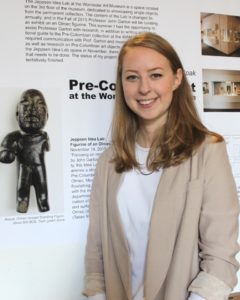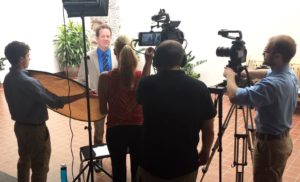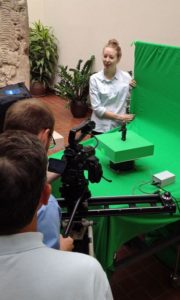Clark University senior Elisabeth “Zizi” Spak recently completed a project for the Worcester Art Museum (WAM), “Jeppson Idea Lab: Statuette of an Olmec Figure,” which was funded through Clark’s Liberal Education and Effective Practice (LEEP) initiative.

Spak’s LEEP project was to help prepare an upcoming exhibit, The Jeppson Idea Lab: Olmec Incised Standing Figure, in a section of the museum dedicated to showcasing single objects from the permanent collection. John Garton, associate professor of art history, is curating this exhibit on the stone Olmec figurine from Mesoamerica’s earliest flourishing culture. Professor Garton served as Spak’s faculty adviser.
Spak helped generate ideas and formulate content for the iPad display for the exhibit, which will be on display in the Jeppson Idea Lab at WAM from November 14, 2015 to April 3, 2016. She researched the museum’s Pre-Colombian collection and wrote the copy for the instructional guide to the collection, ensuring it conformed to Massachusetts’ state curriculum frameworks. Her guides will be used by the Worcester Art Museum and posted on their website.
“Elisabeth worked with me to create an itinerary around the gallery—and has done a great job. Her research of both the Pre-Colombian collection and the Massachusetts’ state curricular frameworks has made this project highly useful to the museum, and because she has a keen eye for graphic design, the tools she helped produce are visually exciting,” said Professor Garton.

“This project required a great deal of research into fields that I ordinarily would not encounter. I had to decipher archeological journals and education frameworks to create a guide that would be straightforward and effective for younger audiences,” said Spak.
By photographing the Pre-Columbian exhibit at the WAM and designing how the guide is arranged, I was able to incorporate art and design into this project,” she said.
Liberal Education and Effective Practice (LEEP) is Clark’s bold effort to advance liberal education, linking a deep and integrated curriculum with opportunities to put knowledge into practice in order to prepare students for remarkable careers and purposeful, accomplished lives.
Now in its fourth year, LEEP projects have helped Clark University students pursue funded and directed problem-based summer projects. The projects—several of which are hosted by Clark alumni—offer real-world application of course material and provide an opportunity to engage with professionals outside of the University. LEEP Projects also enable students to develop marketable skills, and focus on characteristics the University refers to as LEEP Learning Outcomes.

record the Olmec sculpture
This year, 122 undergraduates received funding through Clark’s LEEP initiative to pursue projects ranging from international social action initiatives to internships with leading corporations. LEEP Fellows are expected to devote approximately 150 hours to their LEEP Project and participate in workshops on professionalism and project management. LEEP Fellows complete a written reflection upon completion of their experience and share results with the Clark community in one of the University’s annual undergraduate student research showcases.
Spak majors in cultural studies and communication and studio art at Clark. She is a member of the Class of 2016.
“LEEP Projects provide a tremendous opportunity for our students to connect their academic learning with professional development,” said Vickie Cox-Lanyon, assistant director of the LEEP Center at Clark. “LEEP Fellows are able to explore, in depth, topics about which they are passionate, to integrate their skills and knowledge, and to solve complex problems through creative thinking, collaboration and persistence. Advisors from Clark’s LEEP Center, faculty mentors, Clark alumni and organizational partners work to ensure that each student maximizes his or her opportunity.”


